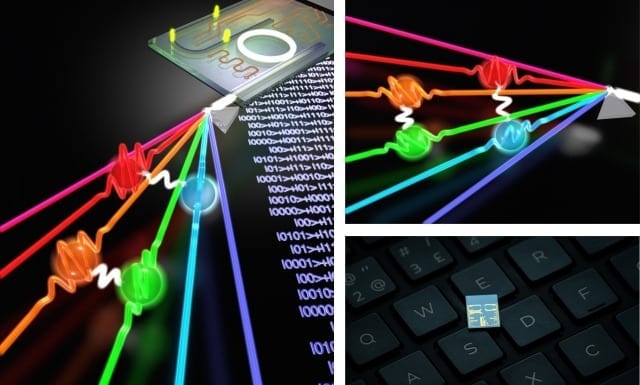
The optical chip developed at INRS by Prof. ’s team overcomes a number of obstacles in the development of quantum computers, which are expected to revolutionize information processing. The international research team has demonstrated that on-chip quantum frequency combs can be used to simultaneously generate multiphoton entangled quantum bit (qubit) states.
Quantum computing differs fundamentally from classical computing, in that it is based on the generation and processing of qubits.Unlike classical bits, which can have a state of either 1 or 0, qubits allow a superposition of the 1 and 0 states (both simultaneously).Strikingly, multiple qubits can be linked in so-called ‘entangled’ states, where the manipulation of a single qubit changes the entire system, even if individual qubits are physically distant.This property is the basis for quantum information processing, aiming towards building superfast quantum computers and transferring information in a completely secure way.
Professor Morandotti has focused his research efforts on the realization of quantum components compatible with established technologies.The chip developed by his team was designed to meet numerous criteria for its direct use:it is compact, inexpensive to make, compatible with electronic circuits, and uses standard telecommunication frequencies.It is also scalable, an essential characteristic if it is to serve as a basis for practical systems.But the biggest technological challenge is the generation of multiple, stable, and controllable entangled qubit states.
The generation of qubits can rely on several different approaches, including electron spins, atomic energy levels, and photon quantum states. Photons have the advantage of preserving entanglement over long distances and time periods.But generating entangled photon states in a compact and scalable way is difficult.“What is most important, several such states have to be generated simultaneously if we are to arrive at practical applications,” added INRS research associate Dr. Michael Kues.
Roberto Morandotti’s team tackled this challenge by using on-chip optical frequency combs for the first time to generate multiple entangled qubit states of light.As Michael Kues explains, optical frequency combs are light sources comprised of many equally-spaced frequency modes.“Frequency combs are extraordinarily precise sources and have already revolutionized metrology and sensing, as well as earning their discoverers the 2005 Nobel Prize in Physics.”
Thanks to these integrated quantum frequency combs, the chip developed by INRS is able to generate entangled multi-photon qubit states over several hundred frequency modes.It is the first time anyone has demonstrated the simultaneous generation of qubit multi-photon and two-photon entangled states:Until now, integrated systems developed by other research teams had only succeeded in generating individual two-photon entangled states on a chip.
The results published in Science will provide a foundation for new research, both in integrated quantum photonics and quantum frequency combs.This could revolutionize optical quantum technologies, while at the same time maintaining compatibility with existing semiconductor chip technology.
Learn more: INRS takes giant step forward in generating optical qubits
The Latest on: Optical qubits
[google_news title=”” keyword=”optical qubits” num_posts=”10″ blurb_length=”0″ show_thumb=”left”]
via Google News
The Latest on: Optical qubits
- AOM - Arizona Optical Metrology LLCon April 30, 2024 at 7:43 am
AOM - Arizona Optical Metrology provides measurement solutions for optical surfaces and systems. Forged by decades of practical experience, we efficiently perform engineering and manufacture custom ...
- April Zenni Optical Promo Code & Coupon Codeson April 29, 2024 at 5:00 pm
Review your order summary and encode your Zenni Optical promo code in the text box and click the “Apply” button. The discount will be applied automatically to the total amount of your order.
- optical mouseon April 27, 2024 at 5:00 pm
If your pointing device is a mouse, turn it over. The chances are you’ll see a red LED light if you’re not seriously old-school and your mouse has a ball, this light serves as the illumination ...
- Individual polyatomic molecules are trapped in optical-tweezer arrayson April 24, 2024 at 8:28 am
Individual polyatomic molecules have been trapped in arrays of optical tweezers for the first time. Researchers in the US were able to control individual quantum states of the three-atom molecules and ...
- Optical memory of crystalson April 14, 2024 at 5:00 pm
These devices can use light in more complex ways, such as for data analysis or information storage, and have potential applications ranging from advanced optical communication and sensing to machine ...
- Discovery Points Path to Flash-Like Memory for Storing Qubitson April 8, 2024 at 12:39 am
Rice University physicists have discovered a phase-changing quantum material — and a method for finding more like it — that could potentially be used to create flash like memory capable of storing ...
- 1762nm Tm-doped Fibre Amplifier for Barium Ion Excitationon April 3, 2024 at 5:00 pm
The 1762nm series of optical amplifiers is ideal for quantum computing applications in the manipulation and control of barium ion based optical qubits, a leading candidate to replace Ytterbium based ...
- Classical optical neural network exhibits 'quantum speedup'on April 2, 2024 at 12:28 pm
"The convolution part in our network is composed of unitary operations on the correlated optical state. "It is like the unitary operations on the Hilbert space of qubits. The pooling part we ...
- Amazing! The classical optical neural network exhibits “quantum speedup”on April 1, 2024 at 5:00 pm
“The convolution part in our network is composed of unitary operations on the correlated optical state. It is like the unitary operations on the Hilbert space of qubits. The pooling part we ...
- Quantum computers move into the lighton February 28, 2024 at 7:39 am
And Furusawa predicts that the long-term direction of quantum computing will be towards optical technologies. “I think the age of conventional qubits based on standing waves is over,” he says.
via Bing News










